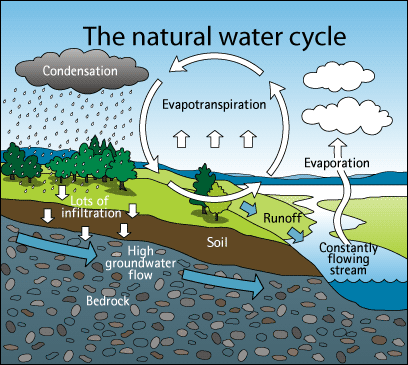The water on our planet is the same water that has been here for millions of years. We all learned about the water cycle back in elementary school- precipitation, evaporation, condensation, and then precipitation again, right? Yes, but there are some key steps they left out in elementary school, leaving unanswered questions like, "Where does the water go after it rains and before it evaporates again?" and "How does it get to our taps?"
Here is the full water cycle, which is at the core of human life, and what we are working to protect here at the Conservancy:
Figure Credit: Auckland City Council
When rain reaches the earth, it can do one of three things:
1. Infiltrate into the ground.
2. Be taken up by plants.
3. Run off the land directly into streams.
The first two options are both natural ways of filtering fresh water. When water infiltrates into the soil, contaminants are filtered out by the rock and soil particles. From there, the water may sink down into a well, from which we draw drinking water.
Or, water can flow underground as a spring, which eventually reaches a stream. This is what keeps our streams flowing in dry weather.
When water is absorbed and used by plants, the molecules the plants do not use are released into the atmosphere to reform pure H2O. This is labeled as 'evapotranspiration' on the figure.
The last option occurs least often in forested, undeveloped areas, which is a good thing. In developed areas like ours, however, roads, roofs, and compacted soils keep rain water from infiltrating or being used by plants so that much more of it runs off over the land. This leads to more flooding, and all that runoff picks up a lot of pollutants on its way to a stream. This affects wildlife, but it also affects humans, because we also draw a lot of drinking water from streams.
As less infiltration occurs, our wells are not being replenished, and our only other source of fresh water, our streams, are being polluted by all that runoff. The good news is there are some easy solutions to reduce the runoff and re-balance the water cycle.
Check out our page on What You Can Do to Protect Our Streams, and see what we are doing to protect rain water.


